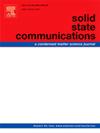三维节点线半金属-超导体体系的各向异性Andreev反射
IF 2.4
4区 物理与天体物理
Q3 PHYSICS, CONDENSED MATTER
引用次数: 0
摘要
量子输运是粒子在介观系统中从一种状态转变为另一种状态的过程。本文构造了一个各向异性三维拓扑节点线半金属超导体(tnlsm - sc)的杂化系统,并利用非平衡格林函数研究了该杂化系统在kx-y和kz-y两种非等效模型下的Andreev反射。结果表明,混合体系的Andreev反射明显,且Andreev反射随费米能量EF的增加而逐渐增强。此外,研究发现,杂化体系的Andreev反射仅涉及tnlsm的体带,Andreev反射与拓扑节点线半金属的各向异性密切相关,表明tnlsm具有各向异性电荷屏蔽行为。Andreev反射的强各向异性行为可以作为实验检测中tnlsm的表征。对于kx-y模型,结果表明,在每个给定kx时,tnlsm的能带结构向ky=0方向移动,表现为两个Weyl节点,导致每个给定kx处的大块能带对混合系统的Andreev反射有贡献。对于kz-y模型,只有kz=0,±π20,±π10的体积带涉及杂化体系的Andreev反射。质量项m的存在在拓扑节点线半金属的能带结构中打开了一个缺口。随着质量项m的增加,杂化体系的Andreev反射涉及的体带数减少,导致杂化体系超导间隙内的Andreev反射变弱。随着现场能量的增大,节点线减小,使得混合体系的Andreev反射逐渐被kx趋近于零的体带所主导。这些丰富的物理性质为在混合系统中构建超导信息存储载体提供了理论指导。本文章由计算机程序翻译,如有差异,请以英文原文为准。
Anisotropic Andreev reflections in the three dimensional nodal-line semimetals-superconductor system
Quantum transport is the process by which a particle changes from one state to another in a mesoscopic system. We construct a hybrid system of the anisotropic three dimensional topological nodal-line semimetals-superconductor (TNLSMs-SC), and the Andreev reflection of the hybrid system under two non-equivalent models (- and - models) is studied by using the non-equilibrium Green’s function. The results show that the Andreev reflection of the hybrid system is obvious, and the Andreev reflection gradually enhances with the increase of Fermi energy . In addition, it is found that only the bulk bands of the TNLSMs are involved in the Andreev reflection of the hybrid systems, and the Andreev reflection is closely related to the anisotropy of the topological nodal-line semimetals, which shows that TNLSMs has anisotropic charge shielding behavior. The strongly anisotropic behaviors of the Andreev reflection can be used as the characterization of TNLSMs in experimental detections. For the - model, it is shown that band structure of the TNLSMs with each given moves in the direction and behaves like two Weyl nodes, resulting in the contribution of bulk bands at each given to the Andreev reflection of the hybrid system. For the - model, only the bulk bands for involve Andreev reflection of the hybrid system. The presence of the mass term opens a gap in the band structure of the topological nodal-line semimetals. With the increase in the mass term , the number of bulk bands involved in the Andreev reflection of the hybrid system decreases, leading to weaker Andreev reflection within the superconducting gap of the hybrid system. As the on-site energy increases, the nodal line decreases, causing the Andreev reflection of the hybrid system to be gradually dominated by the bulk bands where approaches zero. These rich physical properties provide theoretical guidance for constructing superconducting information storage carriers in hybrid systems.
求助全文
通过发布文献求助,成功后即可免费获取论文全文。
去求助
来源期刊

Solid State Communications
物理-物理:凝聚态物理
CiteScore
3.40
自引率
4.80%
发文量
287
审稿时长
51 days
期刊介绍:
Solid State Communications is an international medium for the publication of short communications and original research articles on significant developments in condensed matter science, giving scientists immediate access to important, recently completed work. The journal publishes original experimental and theoretical research on the physical and chemical properties of solids and other condensed systems and also on their preparation. The submission of manuscripts reporting research on the basic physics of materials science and devices, as well as of state-of-the-art microstructures and nanostructures, is encouraged.
A coherent quantitative treatment emphasizing new physics is expected rather than a simple accumulation of experimental data. Consistent with these aims, the short communications should be kept concise and short, usually not longer than six printed pages. The number of figures and tables should also be kept to a minimum. Solid State Communications now also welcomes original research articles without length restrictions.
The Fast-Track section of Solid State Communications is the venue for very rapid publication of short communications on significant developments in condensed matter science. The goal is to offer the broad condensed matter community quick and immediate access to publish recently completed papers in research areas that are rapidly evolving and in which there are developments with great potential impact.
 求助内容:
求助内容: 应助结果提醒方式:
应助结果提醒方式:


